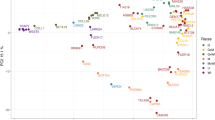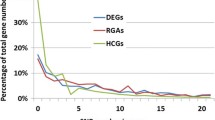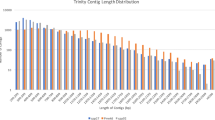Abstract
Natural hybridization occurs in sites where Pinus halepensis Mill. and Pinus brutia Ten. overlap geographically. Studies have shown that these hybrids demonstrate vigorous growth. Currently, there is no efficient method for hybrid identification. In the present study, a transcriptome database that was established from P. halepensis and P. brutia provided 111,388 potential SNP markers for hybrid identification. We selected 295 SNPs that were verified in silico using the Integrative Genomics Viewer (IGV) program. Forty-three SNPs were confirmed in vitro using several methods, including CAPS, HRM, TaqMan, KASP, and direct sequencing. Seven SNPs that were used for genotyping P. brutia trees in three planted sites along the climatic gradient of Israel demonstrated hybrid incidences of 2.5, 6.3, and 9.4%. The trunk volume of the hybrids in these sites was 2.9, 2.4, and 1.2 times larger than that of their P. brutia neighboring trees. Differences among the sites in the hybrid vigorous growth extent might have resulted from several factors, including genetic source, stand age, thinning history, and site conditions. However, the overall vigorous growth of the hybrids that was more pronounced in the arid site highlights the potential of interspecific hybridization as a means for improving the drought resistance of forest trees. This work provides a reliable SNP database for the identification of P. brutia × P. halepensis hybrids for the potential utilization of these hybrids to confront changes in climate.




Similar content being viewed by others
Code availability
Not applicable.
References
Allen CD, Breshears DD, McDowell NG (2015) On underestimation of global vulnerability to tree mortality and forest die-off from hotter drought in the Anthropocene. Ecosphere 6:1–55. https://doi.org/10.1890/ES15-00203.1
Allen CD, Macalady AK, Chenchouni H, Bachelet D, Mcdowell N, Vennetier M, Kitzberger T, Rigling A, Breshears DD, Hogg EHT, Gonzalez P, Fensham R, Zhang Z, Castro J, Demidova N, Lim J, Allard G, Running SW, Semerci A, Cobb N (2010) A global overview of drought and heat-induced tree mortality reveals emerging climate change risks for forests. For Ecol Manag 259:660–684. https://doi.org/10.1016/j.foreco.2009.09.001
Blada I (2004) Genetic variation in growth and blister-rust resistance in a Pinus strobus x P. wallichiana hybrid population. Silva Genet 53:33–41. https://doi.org/10.1515/sg-2004-0006
Bonneh O (2000) Management of planted pine forests in Israel: past, present, future. In: Ne’eman G, Trabaud L (eds) Ecology, biogeography and management of Pinus halepensis and P. brutia forest ecosystems in the Mediterranean Basin. Backhuys Publishers, Leiden, pp 377–390
Boydak M, Dirik H, Callkoglu M (2006) Biology and silviculture of Turkish red pine (Pinus brutia Ten.). Istanbul Universitesi Orman Fakultesi, Ankara
Chambel MR, Climent J, Pichot C, Ducci F (2013) Mediterranean pines (Pinus halepensis Mill. and brutia Ten.). In: Pâques L (ed) Forest tree breeding in Europe. Current state-of-the-art and perspectives. Springer, Dordrecht, pp 229–265. https://doi.org/10.1007/978-94-007-6146-9_5
Choat B, Brodribb TJ, Brodersen CR, Duursma RA, López R, Medlyn BE (2018) Triggers of tree mortality under drought. Nature 558:531–539. https://doi.org/10.1038/s41586-018-0240-x
Conover WJ, Iman RL (1981) Rank transformations as a bridge between parametric and nonparametric statistics. Am Stat 35:124–129. https://doi.org/10.1080/00031305.1981.10479327
Critchfield WB (1975) Interspecific hybridization in Pinus: a summary review. Proceedings of the 14th meeting of the Canadian Tree Improvement Association. New Brunswick, Canada, pp 99–105
Cullingham CI, Cooke JEK, Dang S, Coltman DW (2013) A species-diagnostic SNP panel for discriminating lodgepole pine, jack pine, and their interspecific hybrids. Tree Genet Genomes 9:1119–1127. https://doi.org/10.1007/s11295-013-0608-x
De La Torre AR, Puiu D, Langley CH, Neale DB, Crepeau MW, Stevens K, Salzberg SL (2019a) Genomic architecture of complex traits in loblolly pine. New Phytol 221:1789–1801. https://doi.org/10.1111/nph.15535
De La Torre AR, Wang T, Jaquish B, Aitken SN (2014) Adaptation and exogenous selection in a Picea glauca x Picea engelmannii hybrid zone: implications for forest management under climate change. New Phytol 201:687–699. https://doi.org/10.1111/nph.12540
De La Torre AR, Wilhite B, Neale DB (2019b) Environmental genome-wide association reveals climate adaptation is shaped by subtle to moderate allele frequency shifts in loblolly pine. Genome Biol Evol 11:2976–2989. https://doi.org/10.1093/gbe/evz220
De Lafontaine G, Bousquet J (2017) Asymmetry matters: a genomic assessment of directional biases in gene flow between hybridizing spruces. Ecol Evol 7:3883–3893. https://doi.org/10.1002/ece3.2682
Dounavi A, Koutsias N (2001) Natural interspecific hybridization between Pinus brutia (Ten.) and Pinus halepensis (Mill.), verified by using the logistic regression modeling on morphological characters. For Genet 8:151–158
Doyle J, Doyle J (1990) Isolation of plant DNA from fresh tissue. Focus (Madison) 12:13–15
Dungey HS (2001) Pine hybrids - a review of their use performance and genetics. For Ecol Manag 148:243–258. https://doi.org/10.1016/S0378-1127(00)00539-9
Eckert AJ, Pande B, Ersoz ES, Nicolet CM, Neale DB (2009) High-throughput genotyping and mapping of single nucleotide polymorphisms in loblolly pine (Pinus taeda L.). Tree Genet Genomes 5:225–234. https://doi.org/10.1007/s11295-008-0183-8
Fox H, Doron-faigenboim A, Kelly G, Bourstein R, Attia Z, Zhou J, Moshe Y, Moshelion M, David-Schwartz R (2018) Transcriptome analysis of Pinus halepensis under drought stress and during recovery. Tree Physiol 1:423–441. https://doi.org/10.1093/treephys/tpx137
Ganopoulos I, Aravanopoulos F, Madesis P, Pasentsis K, Bosmali I, Ouzounis C, Tsaftaris A (2013) Taxonomic identification of Mediterranean pines and their hybrids based on the high-resolution melting (HRM) and trnL approaches: from cytoplasmic inheritance to timber tracing. PLoS One 8:e60945. https://doi.org/10.1371/journal.pone.0060945
Gola G (1924) Sopra alcuni ibridi tra Pinus pinaster, P. halepensis e P. brutia dei dintorni di Grado. Atti Accad Sci Veneto-Trentino-Istriana, (Padua) 3:72–74
Goodwin S, McPherson JD, McCombie WR (2016) Coming of age: ten years of next-generation sequencing technologies. Nat Rev Genet 17:333–351. https://doi.org/10.1038/nrg.2016.49
Grotkopp E, Rejmánek M, Sanderson MJ, Rost TL (2004) Evolution of genome size in pines (Pinus) and its life-history correlates: supertree analyses. Evol (NY) 58:1705–1729. https://doi.org/10.1554/03-545
Howe GT, Yu J, Knaus B, Cronn R, Kolpak S, Dolan P, Lorenz WW, Dean JFD (2013) A SNP resource for Douglas-fir: de novo transcriptome assembly and SNP detection and validation. BMC Genomics 14:1471–2164. https://doi.org/10.1186/1471-2164-14-137
Ingvarsson PK, Street NR (2011) Association genetics of complex traits in plants. New Phytol 189:909–922. https://doi.org/10.1111/j.1469-8137.2010.03593.x
Janes JK, Hamilton JA (2017) Mixing it up: the role of hybridization in forest management and conservation under climate change. Forests 8:1–16. https://doi.org/10.3390/f8070237
Karam MJ, Lefèvre F, Dagher-Kharrat MB, Pinosio S, Vendramin GG (2015) Genomic exploration and molecular marker development in a large and complex conifer genome using RADseq and mRNAseq. Mol Ecol 15:601–612. https://doi.org/10.1111/1755-0998.12329
Kitikidou K, Milios E, Radoglou K (2017) Single-entry volume table for Pinus brutia in a planted peri-urban. Ann Silvic Res 41:78–83. https://doi.org/10.12899/asr-1437
Korol L, Madmony A, Riov J, Schiller G (1995) Pinus halepensis x Pinus brutia subsp. brutia hybrids? Identification using morphological and biochemical traits. Silvae Genet 44:186–190
Korol L, Shklar G, Schiller G (2001) Diversity among circum-Mediterranean populations of Aleppo pine and differentiation from Brutia pine in their isoenzymes: additional results. Silvae Genet 51:35–41
Lepoittevin C, Frigerio J-M, Garnier-Géré P, Salin F, Cervera MT, Vornam B, Harvengt L, Plomion C (2010) In-vitro vs in silico detected SNPs for the development of a genotyping array: what can we learn from a non-model species? PLoS One 5:e11034. https://doi.org/10.1371/journal.pone.0011034
Li H (2011) A statistical framework for SNP calling, mutation discovery, association mapping and population genetical parameter estimation from sequencing data. Bioinformatics 27:2987–2993. https://doi.org/10.1093/bioinformatics/btr509
Li H, Handsaker B, Wysoker A, Fennell T, Ruan J, Homer N, Marth G, Abecasis G, Durbin R, Data GP, Sam T (2009) The sequence alignment/map format and SAMtools. Bioinformatics 25:2078–2079. https://doi.org/10.1093/bioinformatics/btp352
Madmony A, Schiller G, Moshe Y, Tsabary G, Mendel Z, Riov J (2003) Controlled and open pollination between Pinus brutia (Ten.) and Pinus halepensis (Mill.) in Israel and hybrid performance. Isr J Plant Sci 51:213–222. https://doi.org/10.1560/FNFR-JCUH-3EEA-0UGJ
McKown AD, Guy RD (2018) Hybrid vigour – poplars play it cool. Tree Physiol 38:785–788. https://doi.org/10.1093/treephys/tpy055
Mendel Z (1998) Biogeography of Matsucoccus josephi (Homoptera: Matsucoccidae) as related to host resistance in Pinus brutia and Pinus halepensis. Can J For Res 28:323–330. https://doi.org/10.1139/x97-211
Menon M, Landguth E, Leal-Saenz A, Bagley JC, Schoettle AW, Wehenkel C, Flores-Renteria L, Cushman SA, Waring KM, Eckert AJ (2020) Tracing the footprints of a moving hybrid zone under a demographic history of speciation with gene flow. Evol Appl 13:195–209. https://doi.org/10.1111/eva.12795
Mirov NT (1967) The genus Pinus. Ronald Press Company, New York
Mitchell RG, Wingfield MJ, Hodge GR, Steenkamp ET, Coutinho TA (2013) The tolerance of Pinus patula x Pinus tecunumanii, and other pine hybrids, to Fusarium circinatum in greenhouse trials. New For 44:443–456. https://doi.org/10.1007/s11056-012-9355-3
Moulalis D, Bassiotis C, Mitsopoulos D (1976) Controlled pollinations among pine species in Greece. Silvae Genet 25:95–107
Muramoto N, Oda A, Tanaka H, Nakamura T, Kugou K, Suda K, Kobayashi A, Yoneda S, Ikeuchi A, Sugimoto H, Kondo S, Ohto C, Shibata T, Mitsukawa N, Ohta K (2018) Phenotypic diversification by enhanced genome restructuring after induction of multiple DNA double-strand breaks. Nat Commun 9:1–15. https://doi.org/10.1038/s41467-018-04256-y
Neale D, Sederoff R (1989) Paternal inheritance of chloroplast DNA and maternal inheritance of mitochondrial DNA in loblolly pine. Theor Appl Genet 77:212–216
Osem Y, Ginsberg P, Tauber I, Atzmon N, Perevolotsky A (2008) Sustainable management of Mediterranean planted coniferous forests: an Israeli definition. J For 106:38–46. https://doi.org/10.1093/jof/106.1.38
Panetsos KP (1975) Natural hybridization between Pinus halepensis and Pinus brutia in Greece. Silvae Genet 24:163–168
Panetsos KP (1986) Genetics and breeding in the group halepensis. CIHEAM - Options Mediterr 86:81–88
Panetsos KP (1981) Monograph of Pinus halepensis Mill. and P. brutia Ten. Ann For 9:39–77
Panetsos KP, Scaltsoyiannes A, Aravanopoulos F, Dounavi A, Dimitrakopoulos A (1997) Identification of Pinus brutia Ten., P. halepensis Mill. and their putative hybrids. Silvae Genet 46:253–257
Papaioannou J (1936) Uber Artbastarde zwischen Pinus brutia Ten. und Pinus halepensis Mill. in Nordost Chalkidiki (Griechenland). Forstwiss Cent 58:194–205
Pinosio S, González-Martínez SC, Bagnoli F, Cattonaro F, Grivet D, Marroni F, Lorenzo Z, Pausas JG, Verdú M, Vendramin GG (2014) First insights into the transcriptome and development of new genomic tools of a widespread circum-Mediterranean tree species, Pinus halepensis Mill. Mol Ecol Resour 14:846–856. https://doi.org/10.1111/1755-0998.12232
Porth I, El-kassaby YA (2014) Assessment of the genetic diversity in forest tree populations using molecular markers. Diversity 6:283–295. https://doi.org/10.3390/d6020283
Robinson JT, Thorvaldsdóttir H, Wenger AM, Zehir A, Mesirov JP (2017) Variant review with the integrative genomics viewer. Cancer Res 77:e31 LP–e31e34. https://doi.org/10.1158/0008-5472.CAN-17-0337
Rockwood DL, Harding KJ, Nikles DG (1991) Variation in the wood properties of the Pinus elliottii x Pinus caribaea var. hondurensis F1 hybrid, its parental species, and backcross to Pinus elliottii in Australia. Proc 21st Southern Forest Tree Improv Conf, pp 233–240
Scaltsoyiannes A, Panetsos KP, Economou A, Tsoulpha P (1994) Micropropagation of the pine hybrid Pinus brutia (Ten) x Pinus halepensis (Mill) by culturing fascicle shoots. Ann Sci For 51:175–182
Semagn K, Babu R, Hearne S, Olsen M (2014) Single nucleotide polymorphism genotyping using competitive allele specific PCR (KASP): Overview of the technology and its application in crop improvement. Mol Breed 33:1–14. https://doi.org/10.1007/s11032-013-9917-x
Smith SM, Maughan PJ (2015) SNP genotyping using KASPar assays. In: Batley J (ed) Plant genotyping: methods in molecular biology (methods and protocols), vol 1245. Humana Press, New York. https://doi.org/10.1007/978-1-4939-1966-6_18
Suarez-Gonzalez A, Hefer CA, Lexer C, Douglas CJ, Cronk QCB (2018) Introgression from Populus balsamifera underlies adaptively significant variation and range boundaries in P. trichocarpa. New Phytol 217:416–427. https://doi.org/10.1111/nph.14779
White TL, Adams WT, Neale DB (2007) Tree improvement. In: White TL, Adams WT, Neale DB (eds) Forest genetics. CABI, Cambridge, pp 285–302. https://doi.org/10.1079/9781845932855.0000
Wright JW (1976) Introduction to forest genetics. Academic Press, New York
Zanewich KP, Pearce DW, Rood SB (2018) Heterosis in poplar involves phenotypic stability: cottonwood hybrids outperform their parental species at suboptimal temperatures. Tree Physiol 38:789–800. https://doi.org/10.1093/treephys/tpy019
Zimin AV, Stevens KA, Crepeau MW, Puiu D, Wegrzyn JL, Yorke JA, Langley CH, Neale DB, Salzberg SL (2017) An improved assembly of the loblolly pine mega-genome using long-read single-molecule sequencing. Gigascience 6:1–4. https://doi.org/10.1093/gigascience/giw016
Acknowledgements
The authors acknowledge Santiago C. González-Martínez from INRA, Bordeaux (France) for providing unpublished SNP data, and Amir Sherman and Ada Rozen for assistance with TaqMan technique. We also would like to thank the David-Schwartz lab members for technical assistance. We would like to thank the editors and three anonymous referees for providing useful comments and suggestions that substantially improved the article.
Funding
This research was supported by research grant IS-4929-16FR from BARD, The United States-Israel Binational Agricultural Research and Development Fund, and by research grant 10-03-408-19 from KKL – JNF, Keren Kayemeth LeIsrael - Jewish National Fund.
Author information
Authors and Affiliations
Corresponding author
Ethics declarations
Ethics approval
Not applicable.
Consent to participate
All authors have contributed to this manuscript, reviewed, and approved the current form of the manuscript to be submitted.
Consent for publication
This manuscript has not been published or submitted for publication elsewhere.
Conflict of interest
The authors declare no competing interests.
Data archiving statement
Data of this project have been deposited with links to BioProject accession number PRJNA658090 in The National Center for Biotechnology Information (NCBI). The raw data from the Illumina sequencing have been deposited in NCBI Sequence Read Archive (SRA) under accession numbers SRR13189310, SRR13189309, SRR13189308, SRR13189307, SRR13189306, and SRR13189305, for pools A–F, respectively.
Additional information
Communicated by G. G. Vendramin
Publisher’s note
Springer Nature remains neutral with regard to jurisdictional claims in published maps and institutional affiliations.
Rights and permissions
About this article
Cite this article
Houminer, N., Doron-Faigenboim, A., Shklar, G. et al. Transcriptome-based single-nucleotide polymorphism markers between Pinus brutia and Pinus halepensis and the analysis of their hybrids. Tree Genetics & Genomes 17, 14 (2021). https://doi.org/10.1007/s11295-021-01496-w
Received:
Revised:
Accepted:
Published:
DOI: https://doi.org/10.1007/s11295-021-01496-w




